Bidriware
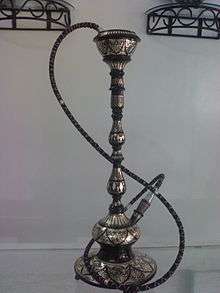
Bidriware (Kannada: ಬಿದ್ರಿ ಕಲೆ ) is a metal handicraft from Bidar. It was developed in the 14th century C.E. during the rule of the Bahamani Sultans.[1] The term 'Bidriware' originates from the township of Bidar, which is still the chief centre for the manufacture of the unique metalware.[2] Due to its striking inlay artwork, Bidriware is an important export handicraft of India and is prized as a symbol of wealth. The metal used is a blackened alloy of zinc and copper inlaid with thin sheets of pure silver.[2] This native art form has obtained Geographical Indications (GI) registry.[3]
Origins
The origin of Bidriware is usually attributed to the Bahamani sultans who ruled Bidar in the 14th–15th centuries. Bidriware originated in ancient Persia. It was brought to India by the followers of Khwaja Moinuddin Chisti.[2] The art form developed in the kingdom was a mix of Turkey, Persia and Arabic countries which were intermingled with the local styles and thus a unique style of its own was born. Abdullah bin Kaiser, a craftsman from Iran was invited by the Sultan Ahmed Shah Bahmani to work on decorating the royal palaces and courts.[2] According to some accounts, Kaiser joined hands with local craftsmen and gave birth to Bidriware under the rule of Second Sultan Alauddin Bahmani. Along with local artisans, the art ware spread far and wide and was handed over to generations as time passed. Fortunately, the art did not die with the kings, it was later on patronized by subsequent kingdoms and today, we can enjoy its exclusivity. It is a family business and in some artisans’ families, even women take part in the making of the metal ware. Since then, the craft has been handed down succeeding generations mostly among the local Muslim and Lingayat sects.
Bidri Artisans
Bidri researcher Rehaman Patel shares that the awardees also had shown their skills by exhibiting varieties of Bidri art in foreign countries. Among them is internationally renowned national awardee Bidri artist Shah Rasheed Ahmed Quadri. On behalf of Karnataka Tableau Shah Rasheed Ahmed Quadri represented a live demonstration of Bidri art in the year 2011 on the occasion of the Republic day at Rajpath in New Delhi. The Govt. of India awarded him with Shilpguru award in 2015.
According to the Census of India 1961, Syed Tassaduq Hussain- a first National awardee (1969) was the Head of the Gulistan Cooperative Society, Bidar. The other notable national awardees are Abdul Hakeem, Mohammed Najeeb Khan, Shah Majeed Quadri, Mohammed Moizuddin, and Mohammed Abdul Rauf.
According to Dr. Patel more than 50 Bidri artisans who received the Karnataka State Award honoured by the Karnataka State Handicrafts Development Corporation.
Process of making Bidriware
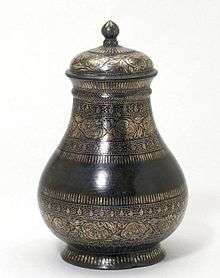
The Birdriware undergoes an eight-stage process. The eight stages are moulding, smoothening by file, designing by chisels, engraving by chisel and hammer, pure silver inlaying, smoothening again, buffing and finally oxidising by soil and ammonium chloride.[4] Bidriware is manufactured from an alloy of copper and zinc (in the ratio 1:16) by casting. The zinc content gives the alloy a deep black color. First, a mould is formed from soil made malleable by the addition of castor oil and resin. The molten metal is then poured into it to obtain a cast piece which is later smoothened by filing. The casting is now coated with a strong solution of copper sulphate to obtain a temporary black coating over which designs are etched freehand with the help of a metal stylus.
This is then secured in a vise and the craftsman uses small chisels to engrave the design over the freehand etching. Fine wire or flattened strips of pure silver are then carefully hammered into these grooves.
The article then is filed, buffed and smoothed to get rid of the temporary black coating. This results in rendering the silver inlay hardly distinguishable from the gleaming metallic surface which is now all silvery white.
The bidriware is now ready for the final blackening process. Here, a special variety of soil which is available only in the unlit portions of the Bidar fort is used.[5] It is mixed with ammonium chloride and water to produce a paste which is then rubbed onto a heated bidri surface. The paste selectively darkens the body while it has no effect on the silver inlay.
The paste is then rinsed off to reveal a shiny silver design resplendent against the black surface. As a finishing touch, oil is applied to the finished product to deepen the matt coating. The finished product appears black with brilliant silver inlay.
The Soil Speciality
It is said that the soil of Bidar is very special. No one knows exactly what is special about it. Some artisans feel that the soil is away from the sunlight and rain for years and therefore it has great oxidizing properties. Others believe that the part of the fort from where soil is brought was a mine and therefore metal extracts in the soil make it unique. The artisans say that the quality of the Bidri earth is very important and the real art lies in testing the mud which is necessary for making the articles. It is tasted by the artisans by their tongues and then decided whether to use it or not. This knack comes from experience and is passed on to next generation. Another important thing is that all the process of making the Bidriware starting from casting to oxidation is done by hand and therefore it is time consuming and hence costlier too.
Designs
Traditionally, various flowers (known as Asharfi-ki-booti), leaves (vine creepers), geometric designs, human figures, stylized poppy plants with flowers etc. are commonly found on the items. Demand for the design of Persian roses and passages from the Holy Quran in Arabic script are also in great demand in the West.
Earlier, Bidriware were used for making hookahs, paan-holders and vases but now keepsakes, bowls, earrings, trays, ornament boxes, other jewelry and showpiece items are made from it.[3] There are craftsmen in this art practice who took this practice to national and international recognition. One of them is Shah Rasheed Ahmed Quadri is a recipient of several awards like National award which he received in 1988, Karnataka state award in 1984, Rajyostava award in 2006, Great Indian Achievement award in 2004, and District Rajyotsava award in 1996.[6]
In Aurangabad, artisans also make designs of motifs from Ajanta Caves especially Ajanta Padmapani which have become very popular among foreign tourists.
Innovations
This world famous artistic metallic work is on the revival path after the introduction of innovative designs and a variety of new patterns. The designs range from Indian to international themes with the latest in home and lifestyle accessories. Innovative designs are developed by the National Institute of Fashion Technology (NIFT). Karnataka State Handicrafts Development Corporation Limited is keen on promoting the Bidri art form.[3]
The traditional art which is identified with a limited set of designs is now trying to diversify and find a foothold in the present-day market and appeal to younger patrons. New items include USB drive covers, office stationeries such as paper clips, key bunches, lockets, envelope openers, pen stands, lampshades and even floor tiles. National Institute of Design has come up with novel & lighter items that uses less silver and therefore costs lesser.[7]
Bidriware can be purchased online on the Karnataka government's Cauvery emporium website.[2]
Bidriware in other places
While Bidar in Karnataka and Hyderabad in Telangana are the most vibrant centers, this art is also practiced in few other parts of the country like Purnia in Bihar, Lucknow in Uttar Pradesh and Murshidabad in West Bengal. The designs are mostly conventional ranging from creepers, flowers and sometimes human figures.
In Bellori, a village near Purnia, local craftsmen known as the Kansaris are engaged in molding and turning bidri vessels. The sonars (goldsmith) then do the engraving and polishing. Also found here is the gharki a less sophisticated variant of the Bidri. Another variant of the bidriwork can be seen in Lucknow’s Zar Buland, where the ornamental designs are raised above the surface.
In Aurangabad, the Bidri art was introduced by the Nizam of Hyderabad as it was a part of Nizam’s empire then. As Aurangabad has its own rich legacy of art and craft,the Bidri work mingled into the local arts soon.
Research in Bidri Art
Gulbarga-based artist Rehaman Patel has done an extensive research on Bidri Art collecting all evidences of historical background of bidri, methods of making bidri, critical review of bidri items collection in India and abroad museums, introduction of bidri artisans and so on. His research on "Bidri Art of Karnataka" was submitted to Gulbarga University and same was awarded in the year 2010. The Indian Royal Academy of Art and Culture has published a book on "Karnatakada Bidri Kale" (Bidri Art of Karnataka) under the financial assistance of Department of Kannada and Culture, Govt. of Karnataka in the year 2012.
Dr. Patel is a fellow of Karnataka Shilpakala Academy Bangalore for the year 2016. He submitted a documentation on "International collection of Bidri Art". He has many articles to his credit on Bidri Art.
Gallery
-
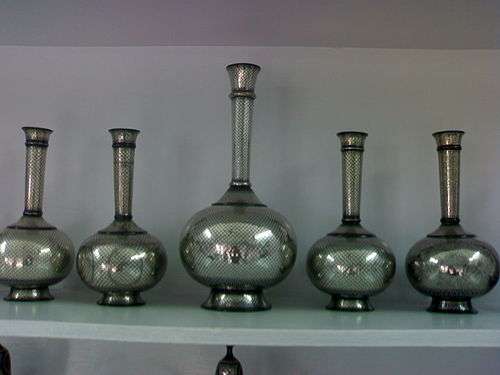
Bidri Vases
-
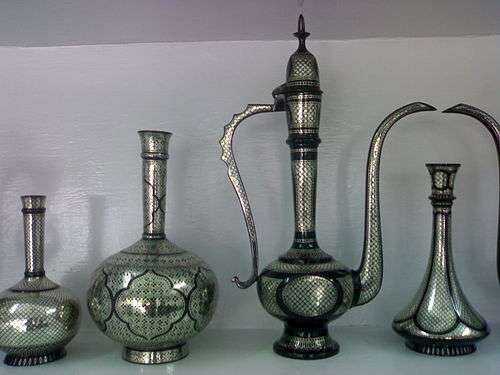
Bidriware vases and decanter
-
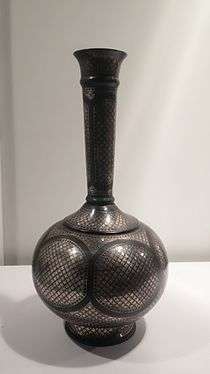
Bidriware Pot
-

The Karnataka tableau depicting Bidriware Handicraft from Bidar passes through the Rajpath during the Republic Day Parade 2011 in New Delhi
-
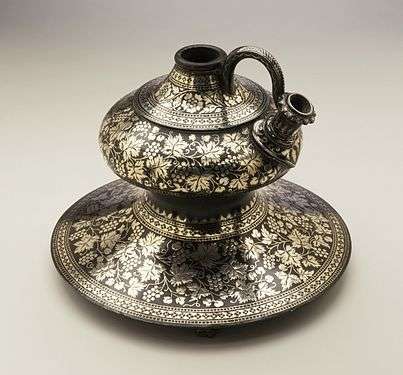
A 1775 water pipe base displayed in Los Angeles County Museum of Art.
References
- ↑ "Proving their mettle in metal craft". timesofindia. January 2, 2012. Retrieved January 2, 2012.
- 1 2 3 4 5 "Karnataka tableau to feature Bidriware". The Hindu. 11 January 2011. Retrieved 6 March 2015.
- 1 2 3 "Innovative designs help revive Bidriware". The Hindu. 26 March 2008. Retrieved 6 March 2015.
- ↑ http://www.thehindu.com/todays-paper/tp-national/tp-karnataka/there-is-sweat-and-toil-behind-every-bidriware/article1560653.ece
- ↑ "Bidriware mementos for delegates at Kannada Sahitya Sammelan". The Hindu. Chennai, India. 2006-01-25. Archived from the original on 23 April 2007. Retrieved 2007-04-25.
- ↑ http://www.thehindu.com/todays-paper/tp-national/tp-karnataka/bidriware-artisan-quadri-invited-to-oman/article372338.ece
- ↑ "Medieval art form gets modern twist". The Hindu. 8 August 2014. Retrieved 6 March 2015.
- This article incorporates text from a publication now in the public domain: Wood, James, ed. (1907). "article name needed". The Nuttall Encyclopædia. London and New York: Frederick Warne.
Further reading
- Dr. Rehaman Patel, Karnatakada Bidri Kale" (Bidri Art of Karnataka) Ph.D. thesis, Dept. of Studies in Visual Art, Gulbarga University, Karnataka-India 2010 published by Dept. of Kannada and Culture, Govt. of Karnataka, 2012
- Dr. Rehaman Patel, Bidri Art- Inlaid Metal Art from Bahmani Sultanate, Un published English Book.
- Krishna Lal, Catalogue, National Museum Collection Bidri Ware, National Museum of India, New Delhi, 1990
- Susan Stronge, Catalogue, Bidri Ware: Inlaid Metalwork from India, Victoria and Albert Museum, London, 1985
- Narayan Sen, Catalogue on Demascene and Bidri Art, Indian Museum Culcutta, 1983
- Anil Roy Choudhury, Catalogue, Bidriware, Salar Jung Museum, Hyderabad, 1961
- Ghulam Yazdani, Bidar-Its history and monuments, published by Nizam Government, printed at Oxford press London, 1947
- Dr. Rehaman Patel, Jagattina Bidri Kalegala Ondu Vishesha Adhyayana (A study on International Bidri Art works) fellowship project submitted to Karnataka Shilpakala Academy Bangalore, 2016
External links
| Wikimedia Commons has media related to Bidriware. |
- Article about Bidriware in The Hindu
- Beautiful and breathtaking deccanherald.com
- About Bidriware on Official Bidar website.
